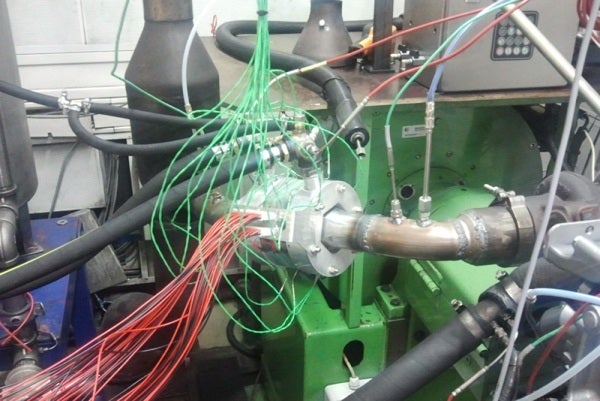
Magna’s Plate Design at the engine test bench.
Based on the Seebeck-Effect, Thermoelectric Generators (TEG) can convert unused exhaust gas heat into useful electrical energy. The generated electrical energy can be fed into the vehicle’s board-net, allowing for a lower use of the alternator and consequent reduction of exhaust emissions. This reduction in CO2 emissions helps meet the ever-increasing exhaust emission standards, and due to the high annual mileage of long-haul trucks, this is a promising application for this technology.
During a multi-year programme funded by the Austrian Research Promotion Agency (FFG), Magna Powertrain’s ECS investigated the thermoelectric waste heat recovery of commercial vehicles. Different thermoelectric generators for diesel-powered commercial vehicles were studied with the help of mathematical models and simulations. Preliminary studies were published in KULI Newsletter 1/2010 and 2/2011.
Two concepts, which are particularly promising, have been investigated within the last years:
- Z-Design
- Plate Design
The Z-Design consists of commercially available thermoelectric modules (BiTe). The modules are clamped between the hot exhaust gas side and the cold coolant water side of the thermoelectric generator. The hot exhaust gas side (three pieces) is made of steel channels with integrated fins that improve convective heat transfer between the hot exhaust gas and the metal surface. Further, baffle plates are used to distribute the fluid as homogeneously as possible, and the coolant water flows through meandering channels. The flow of hot exhaust gas and cold coolant water has been optimised with in-house KULI software and CFD simulation methods.
The plate concept is characterised by a very compact design with integrated exhaust gas and coolant water channels. Thermoelectric material (BiTe) is mounted on the outside of a plate. Through the buildup of individual plates arranged one behind the other, a simple and inexpensive concept has been developed with a high proportion of identical parts. Furthermore, the thermoelectric generator is easily adaptable by adding or removing individual plates. The plates can be formed into circular, oval, square, rectangular or polygon shapes.
Two categories of intensive numerical simulations have been implemented:
- 3D CFD simulations for flow optimisation of dynamic heat transfer, pressure drop, and mass of the heat exchanger structure
- 1D models (electrically coupled thermal fluid) integrated into vehicle models, which allow the investigation of the thermoelectric generator and its influence on the overall vehicle in dynamic driving cycles
Both concepts have been comprehensively measured and evaluated on the motor test bench at Magna Powertrain’s ECS. The results of these tests demonstrate the potential of this technology for exhaust gas waste heat recuperation. The investigated systems are currently in the prototype stage, and therefore further efficiency improvements can be expected. Also, comprehensive research activities are necessary to reach further improvements of thermoelectric material in the future. The materials must withstand the weight of automotive applications and have an industry typical long-term stability. The commercial success of this technology also depends on the successful industrialisation of the manufacturing process for used thermoelectric modules.
Considering all these factors, a serial application of TEG technology appears unrealistic before 2020.

